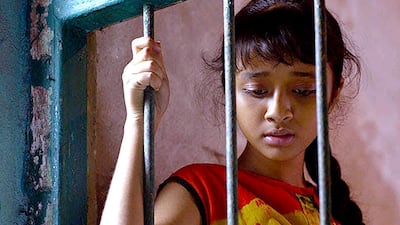Sold, a new film that will open the London Indian Film Festival on July 10 and which is based on the 2006 book by Patricia McCormick, tells the story of Lakshmi, a 13-year-old Nepalese girl who is sold into sexual slavery in India.
Jeffrey D Brown, the director, is well regarded for his work centring on children's stories, including his adaptation of the children's book Molly's Pilgrim (1985), which won him an Academy Award. He then moved into commercials directing, screenwriting and directing television shows, including The Wonder Years.
Brown, who grew up in Uganda and whose stepfather is of Bengali descent, first spent three months in India at the age of 10. “India blew my socks off,” he says. So it is not surprising that when he picked up McCormick’s book, he immediately wanted to adapt it for the big screen.
“I think all of us who are alive are dealing, every moment, with both our fear and our love,” says Brown. “We are constantly pulled between love and fear. So we are all prisoners of our mind. The bigger theme for me in the film is that we are all interconnected and interrelated and we won’t, as a species, survive unless we start dealing with everyone as if they are our family. That theme is very much at the core of the film. Sexual slavery is a huge issue, obviously, but the bigger issue is that we are jailed by inherited fears from our ancestors ... a lot of the sex slavery in India is very much a result of having once been a colony.”
Sold, which will be released in India next year, is about a photographer named Sophia, who visits India to take pictures of young girls sold into slavery. The role is played by Gillian Anderson and is inspired by the photographer Lisa Kristine, who is friends with the director.
“Gillian Anderson and David Arquette are friends of mine. They came on board before we did any Indian casting,” says Brown, adding that the Indian actors include Sushmita Mukerjee and Tillotama Shome.
“But the key to making the film was always going to be the casting of the girl who would play Lakshmi. We spent six months travelling through Nepal and India and auditioned more than 1,000 girls before we found Niyar Saikia in Assam. Niyar has a 10-year scholarship from the Indian government to study acting and has already been identified as a talent. Her mum is a music composer and her dad is a singer.”
Another key aspect of getting the film made was securing the Oscar-winning actress Emma Thompson as the executive producer.
Brown went to New York to meet Thompson, who was in the city for an art installation she co-curated called Journey. The installation uses shipping containers to give people a sense of what victims of human trafficking experience.
“I missed Emma by a day, but met with Helen Bamber, who runs a foundation that supports women suffering from post-traumatic stress disorder as a result of human trafficking,” says Brown
Thompson, who is president of the Helen Bamber Foundation, “was blown away by the script and gave us her name to use, which helped us get the funds. Emma is someone who does yoga with the survivors every week so she is very deeply versed and engaged in this issue.”
The film is being used to raise awareness about human trafficking and Brown hopes to raise money to help organisations in India as well as the Bamber Foundation.
“For me, the film will be a success if some of these children can rebuild their lives, and if we can help them with education and training to support themselves in a dignified manner,” says Brown.
artslife@thenational.ae


